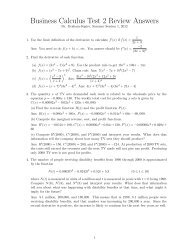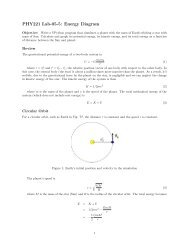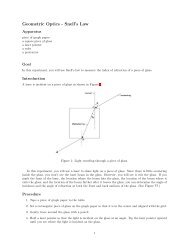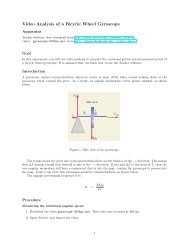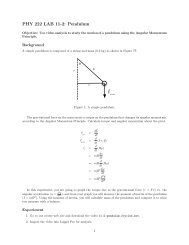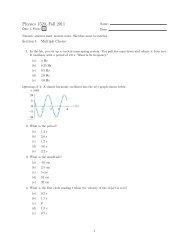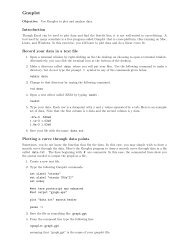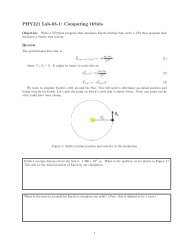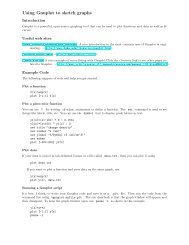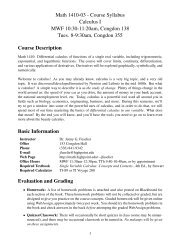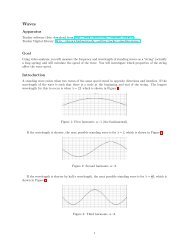Chapter 5--Energy Accounting Analogy Conservation of Energy ...
Chapter 5--Energy Accounting Analogy Conservation of Energy ...
Chapter 5--Energy Accounting Analogy Conservation of Energy ...
You also want an ePaper? Increase the reach of your titles
YUMPU automatically turns print PDFs into web optimized ePapers that Google loves.
<strong>Chapter</strong> 5--<strong>Energy</strong><br />
Surroundings<br />
System<br />
<strong>Accounting</strong> <strong>Analogy</strong><br />
<strong>Conservation</strong> <strong>of</strong> <strong>Energy</strong><br />
Surroundings<br />
Your bank accounts<br />
Simplest System – a particle<br />
Particle <strong>Energy</strong><br />
A particle can only have two kinds <strong>of</strong> energy:<br />
A particle <strong>of</strong> mass m has a total energy E<br />
1. Kinetic energy (energy <strong>of</strong> motion)<br />
2. Rest energy (associated with mass)<br />
The sum <strong>of</strong> rest energy and kinetic energy is the total<br />
energy <strong>of</strong> the particle, called particle energy.<br />
It can be broken into two parts: energy at rest (rest<br />
energy) and energy <strong>of</strong> motion (kinetic energy).
Kinetic <strong>Energy</strong> - <strong>Energy</strong> <strong>of</strong> Motion<br />
Poll<br />
Objects that are moving have energy associated<br />
with their motion, called kinetic energy.<br />
Units are Joules (J).<br />
1 J = 1 N m<br />
A particle in a particle accelerator is accelerated from<br />
a speed <strong>of</strong> 1x10 7 m/s to 2.98 x 10 8 m/s, the kinetic<br />
energy <strong>of</strong> the particle<br />
(increases, decreases, remains constant)<br />
and therefore its change in kinetic energy is<br />
(positive, negative, zero).<br />
1. increases; positive<br />
2. decreases; negative<br />
3. remains constant; zero<br />
Poll<br />
You drive your car at a constant speed <strong>of</strong> 45 mph<br />
for 30 s. During this time interval, the change in<br />
your kinetic energy is<br />
Poll<br />
While in your car, you double your speed from 20<br />
mph to 40 mph. Your kinetic energy at 40 mph is<br />
1. positive<br />
2. negative<br />
3. zero<br />
1. the same as your kinetic energy at 20 mph<br />
2. 2 times your kinetic energy at 20 mph<br />
3. 4 times your kinetic energy at 20 mph<br />
4. 8 times your kinetic energy at 20 mph<br />
<strong>Energy</strong>, momentum, and mass<br />
<strong>Conservation</strong> <strong>of</strong> <strong>Energy</strong><br />
System
Closed and Open Systems<br />
Work<br />
System<br />
System<br />
An (external) force on the system by the<br />
surroundings does work on the system, which either<br />
adds energy to the system or removes energy from<br />
the system.<br />
closed system<br />
open system<br />
Positive work transfers energy to the system from<br />
the surroundings.<br />
Negative work transfers energy from the system to<br />
the surroundings.<br />
Simple System -- A particle<br />
Consider a VERY simple system that only has kinetic<br />
energy and rest energy--(i.e. a particle).<br />
Poll<br />
If a force does positive work on the system, the kinetic<br />
energy <strong>of</strong> the system<br />
System<br />
Surroundings<br />
1. increases<br />
2. decreases<br />
3. remains constant<br />
System<br />
Surroundings<br />
Poll<br />
Consider a VERY simple system that only has kinetic<br />
energy. If a force does negative work on the system, the<br />
kinetic energy <strong>of</strong> the system<br />
Calculating work<br />
F<br />
!r<br />
F<br />
1. increases<br />
2. decreases<br />
3. remains constant<br />
System<br />
Surroundings<br />
Only the component <strong>of</strong> the force parallel to the<br />
displacement (<strong>of</strong> the point <strong>of</strong> application <strong>of</strong> the force)<br />
does work on the system.
Work by a varying force along a varying<br />
path.<br />
During a training run, a<br />
person pushes the<br />
bobsled with a force <strong>of</strong><br />
100 N at an angle <strong>of</strong> 20°<br />
downward (from the<br />
horizontal) for a distance<br />
<strong>of</strong> 5 m. How much work<br />
did she do on the<br />
bobsled<br />
Example<br />
Example<br />
How much work is needed to speed up an electron<br />
from 0.1c to 0.9c<br />
Example<br />
A non-constant force N acts through a straightline<br />
displacement



